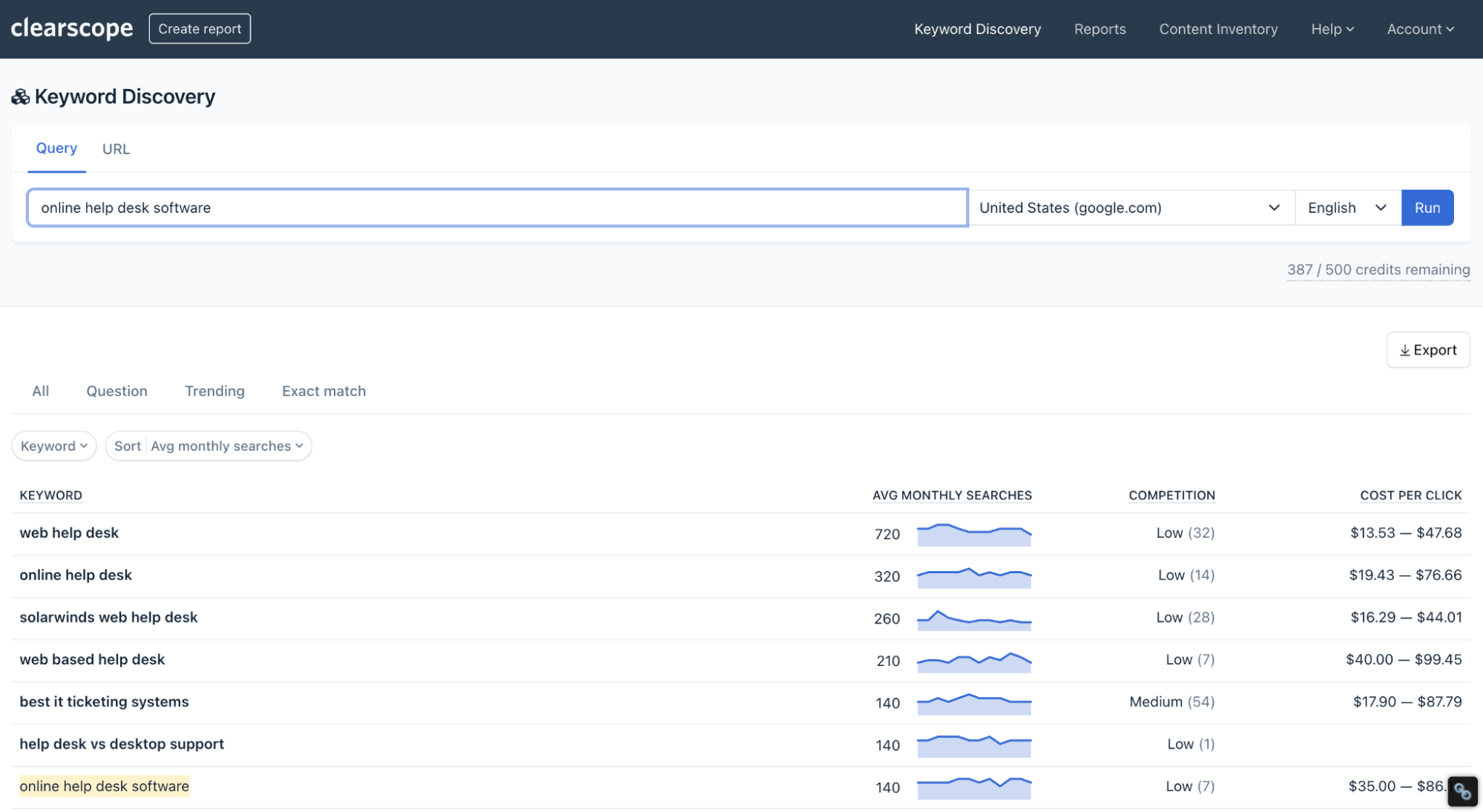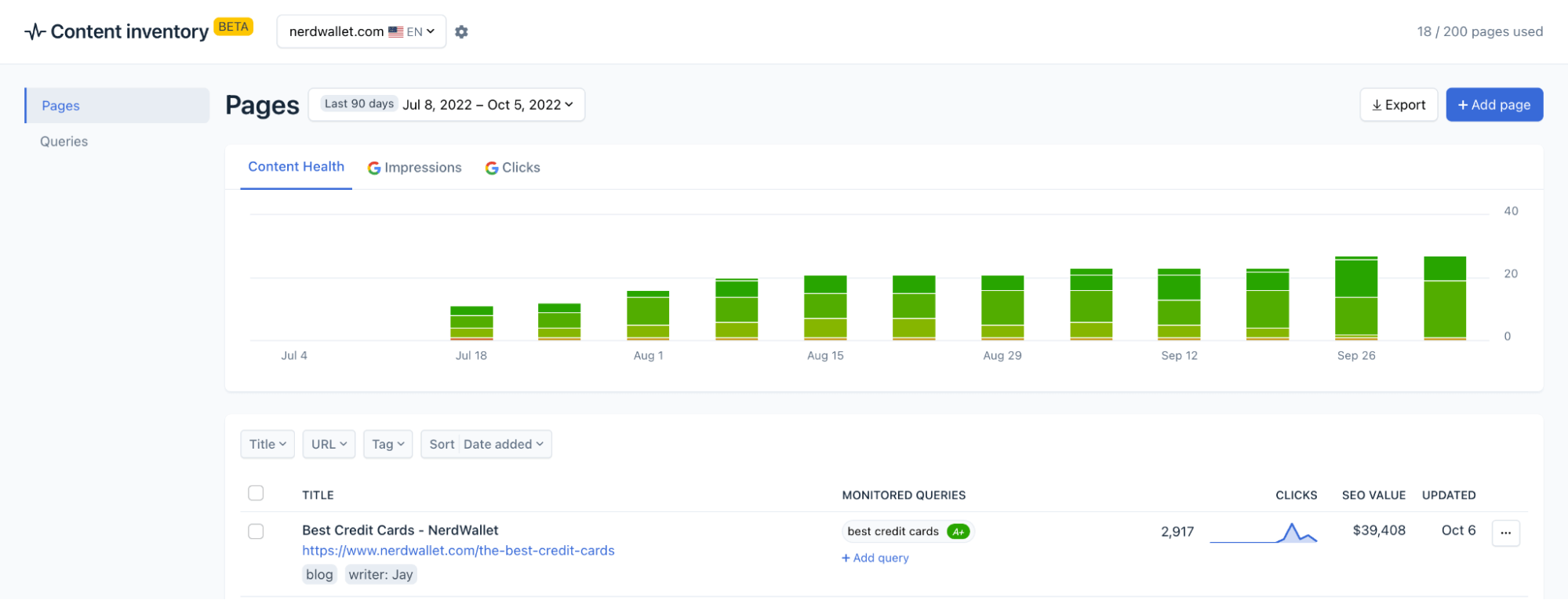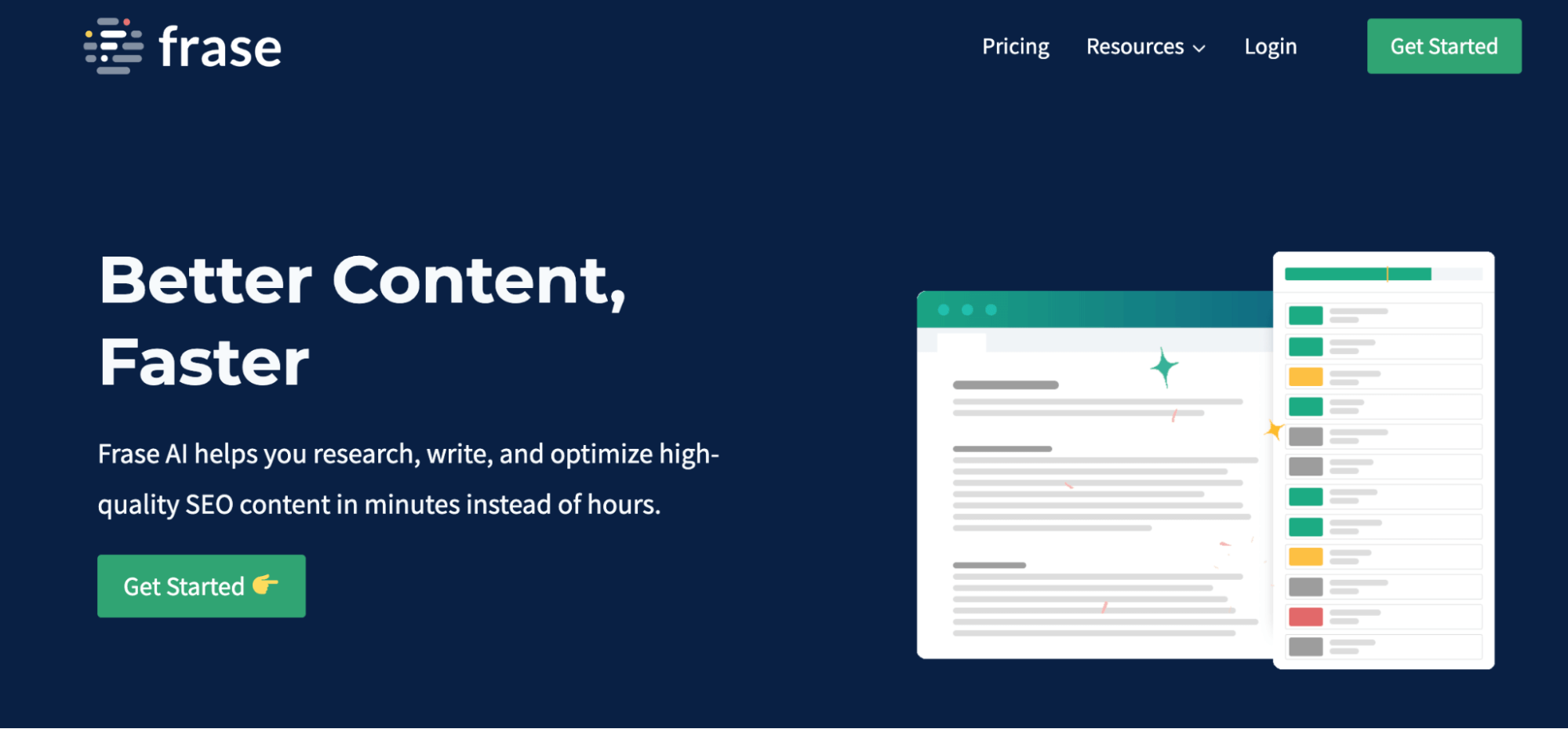5 SEO Writing Assistants to Support Content Creation in 2024 and Beyond
Topic: SEO
Published:
Written by: Bernard Huang
There are two common types of SEO writing assistants (and the one you prefer will mostly depend on your workflows and goals).
Content optimization platforms with features to guide and streamline the strategic writing process — you might be interested in these if your goal is to produce unique, conversion-oriented content more efficiently.
SEO tools with AI writers designed to “do the job for you” — teams with a high volume of content to churn out and limited writing resources might look for these solutions.
Now, we also understand that interest in AI is as prevalent as ever; a lot of teams may feel tempted to use these tools in their writing workflows to save time. Why dedicate resources to writing content when you can train a machine to create it for you?
However, in most cases, we don’t recommend this solution. It may work for some teams, and we don’t want to discredit it completely. But as we’ve learned more about AI tools, and heard feedback from customers who have used these tools, we have a few concerns:
The content produced is mostly generic. These tools can write about high-level topics, but even then, most of the content it generates is just a remix of what’s already published online. These tools basically analyze target keywords, understand what ranks, then regurgitate a new version of the content already produced on the topic. You lose all originality — so the chance of standing out in search results or engaging readers is slim.
These tools can’t write strategic content around particular goals, share original opinions, or produce thought leadership content. Say you’re publishing content to drive sales to a certain product: you’ll likely experience challenges training AI to understand specific value points, and it’s rare that AI writers can truly represent your business offerings in the best light.
These tools aren’t actually all that time-saving. Sure, AI produces content instantly, but sometimes it’s incorrect or illogical (and as we’ve mentioned, generic). So you can still spend hours remixing AI content so it’s original, engaging, tailored to your business goals, etc. And sometimes, trying to remix content can be more challenging and time-consuming than crafting original content from the start.
That’s why we say: content marketing teams that want to optimize their processes are better off choosing a content optimization platform (option #1 above).
These solutions mesh with your existing workflows to support and guide each stage of content development. They allow you to maintain the strategic, creative aspect of the writing process, while simultaneously optimizing content for SEO and reader intent. Writers can produce high-quality, value-driven content faster and more easily.
Content optimization software (like Clearscope!) gives writers clear direction to:
Tackle SERP and competitive analysis.
Determine positioning, draft titles, and outline content.
Write high-quality, SEO-friendly content around specific objectives.
We’ll show you how our solution works in this guide. We’ll also review four other content optimization tools so you can compare popular SEO writing assistants and find the best solution for your business.
Note: Clearscope is our product. We’re proud of what we’ve built and believe we have the best content optimization and monitoring platform on the market. Request a personalized demo.
1. Clearscope
SEO writing assistant to guide & streamline content creation
Clearscope’s SEO writing solution is designed to guide content optimization strategies within natural writing workflows — our reports support topic research and show you important criteria to touch on as you outline, draft, and edit content. You can focus content around reader intent and marketing goals, while also catering to search engines.
Our tools significantly speed up the writing process — Animalz uses Clearscope to save 3 hours per article.
We provide clear recommendations in content reports so you can shave down research time, easily build clear outlines, and optimize content as you write and edit. (And we don’t overload you with recommendations, so the process isn’t confusing or clunky.)
Our reports also show real-time progress — you can see which criteria you’ve covered, check readability, and monitor your content grade — and work through each stage of content creation more productively. There are no doubts about what to include in content, or guessing about whether you’re on the right track.
Let’s quickly review our features to show you how Clearscope enables writing teams to produce high-quality, optimized content at scale.
Feature overview
Clearscope’s tools make writing SEO-friendly content a seamless process so you can (quickly and easily) produce unique content that ranks and performs well. Specifically, we provide:
Keyword research tools to learn more about topics and who you compete with in search engines.
Content reports with heading suggestions, topics to cover, and terms to include in content — we show you competitor’s outlines, important themes, questions to answer, and more so you can write optimized content that stands out in search engines.
Content Inventory dashboard to monitor published content and manage updates (so it can continue to rank well and perform for you).
Keyword Discovery
Before writing, you can use the Keyword Discovery feature to learn more about the target keyword. We display metrics like search volume and list related keywords you might also want to target in your piece of content.

Clearscope's Keyword Discovery
You can instantly click to the search engine results page (SERP) and look at who you’re competing with. This lets you get a better understanding of search intent to determine where you fit into the mix — you can use these insights to start thinking of title ideas and ways to position content to engage readers.
(Then, you can perform more in-depth research on target keywords within our content reports.)
Performing keyword research and competitive analysis is critical in planning strategies to write unique content that engages readers and caters to their goals. We won’t get into all this here, but you can learn more about this step in our guide: Analyzing User Intent for Better SEO Results.
Content Reports
Our content reports offer true writing assistance, helping you get from outline to high-quality content in one fell swoop. Our reports even integrate with Google Docs so you can reference our suggestions in the tools you already use to write content.
Here’s how it works:
First, we have competitive analysis tools to continue keyword research — the ‘Competitors’ tab shows you who’s ranking in the top SERP positions. You can see each page’s title, URL, content length, and SEO score to understand what you’re up against in search results. Then, you can click on competitor sites and review the type of content ranking for that keyword.

Clearscope's competitive content analysis tools
This has a few benefits — not only can you gauge the strengths and weaknesses of competitor content, but you can dig deeper into search intent and learn more about target audiences’ goals.
Are readers simply researching a topic? Are they shopping products and looking for a list of recommendations? How should you craft content to appeal to the Googler and perform well in the SERP?
From there, you can click into the ‘Research’ tab to see key takeaways from the SERP — like themes and commonly-asked questions — and determine snippet optimization strategies to help you choose which sections and FAQs to add to content.

Themes and takeaways from Google Search results
Next, we have the outline builder: our reports show you competitor outlines so you can identify important sections and develop strategies to outperform competitor content. How can you deliver something more valuable, helpful, and different from what’s already appearing in search engines?

Clearscope SEO content templates
You can paste headings into your outline, but our reports also show suggested terms to use in headings (in the ‘Terms’ tab), so you can draft your own. You can filter suggested terms by “Heading” to see all of the heading ideas. It’s also a good idea to consider the themes and FAQs (from the ‘Research’ tab above) as you create your outline.
With Clearscope, you can build outlines faster while ensuring you touch on relevant information and fully satisfy user intent.
Finally, when it comes time to write content, we show you topics and terms to cover so you can write and optimize content at the same time. It’s a good idea to review the list of terms before writing — you can even use the semantic grouping feature to organize similar terms and get a broad idea of the topics you need to cover.

Clearscope SEO suggestions
We suggest writing content as you normally would, without getting too caught up in the list of recommendations. Why? Because when you put in the research to fully understand the topic and user intent before drafting, you can (in most cases) naturally write content that caters to both sides of the coin — the actual reader and search engine crawlers. You already know what’s important and what to write about.
You can reference the list as you write — you can also see your SEO score, word count, and readability grade as you draft — but when you understand the topic well, you can weave in our recommendations without trying too hard.

Clearscope Content Editor
Plus, as we mentioned above, our platform is designed with the natural writing process in mind:
We provide mostly single-term keyword suggestions (instead of long phrases) so it’s easier to include our recommendations within content.
We double-check that suggestions are unique, so there aren’t multiple variations of recommended terms and phrases, and you can avoid keyword stuffing or sounding robotic in your copy.
We use natural language processing to pick up on variations of suggestions, so even if you don’t use the exact word or phrase we recommend, you can still check off important boxes.
We show you the significance of each suggestion, so you can see what’s important to include (and avoid stressing over the not-so-important details).
Reports also provide definitions and examples for each suggestion, so if you’re writing about a new concept, you can reference background information and learn how to talk about topics confidently.
Once the rough draft is complete, editing and making final touches to content is easy: you can filter suggestions by “Unused” to incorporate leftover terms and achieve the recommended content grade, then review for spelling and grammar mistakes, check tone, and improve readability… as you likely already do in your normal workflows.
Then, you can add internal links, external links, images, and alt-text, as the last step before publishing. (You can also follow this checklist to make sure you include all of the important on-page SEO elements.)
Voila! You’re ready to publish.
Even though our platform isn’t generating content for you, it streamlines the entire writing process because it provides clear-cut direction to position, outline, draft, and optimize content.
Our content reports guide content optimization while allowing you to maintain originality in your writing. You know what topics interest readers, who you compete with, and how to make your name in the space. You can put yourself in the best position to rank highly in search engines, increase organic traffic, and convert readers.
Clearscope’s writing assistant lets you create original, value-driven content more effectively, and avoid the risks of AI writing (e.g., publishing generic content, not engaging readers, not competing well in SERPs, not accurately representing your brand, spending hours remixing content).
Content Inventory
After you dedicate time and resources to producing high-quality content, you want it to perform well (and continue performing well) so you can see ROI from content marketing.
However, most teams don’t think to track content beyond looking at traffic and conversions from web pages. So Clearscope offers “Content Inventory” so you can monitor your web pages’ SEO scores and know exactly when content needs updates (and how to update it).

Clearscope Content Inventory
This dashboard is easy to set up and reference: paste URLs of the pages you want to track and add each page’s target keyword. We stay up-to-date with Google algorithm and ranking changes to show you content’s current SEO score each time you check the dashboard.
Then, when you notice content scores dip, you can refresh content to improve performance. This lets you get in front of updates before content loses rankings or traffic. Content doesn’t fall through the cracks, and you can prevent content decay. (Not to mention, this helps you avoid wasting time updating content that doesn’t need it.)
Note: We also have a WordPress plugin so you can reference Clearscope reports in your CMS and easily re-optimize content within WordPress.
Read more: How to Perform a Content Inventory & Audit (2023 Guide)
Try our SEO writing assistant
Clearscope’s features let you manage content creation under one roof: we provide collaborative functionality so content writers and editors can work together. Not to mention, all Clearscope reports are shareable — and sharing is completely free — so you can send reports to freelance content creators, or any writers you partner with, and they can use our tool in their workflows.
Plus, our platform is easy to use and requires no training, so whether you’re just learning how to write SEO content or you’re looking to support a large team of writers, you can easily get started in Clearscope. (We offer pricing and packages for individuals, small teams, and enterprise users.)
Read more: How Speechify Uses Clearscope to Write More than 500 Posts per Month
2. Semrush

Semrush homepage
Semrush is a popular digital marketing solution because it has dozens of toolkits to support various marketing team needs. For example, they have local SEO tools, features to power PPC campaigns, backlink management tools, and solutions for agencies. In addition, they offer the Semrush SEO Writing Assistant — this feature includes an AI writing tool and provides actionable tips to write SEO-friendly content.
You can use their tool to generate AI content, edit spelling/grammar mistakes, revamp tone of voice, and improve readability. The platform also has a plagiarism checker to avoid duplicate content — which, as we stated, can be an issue when working with AI tools.
Recommended reading: How To Engineer Better AI Prompts for Your SEO Content Strategy
You might be interested in Semrush’s solution if you already use the platform for other tasks. However, most teams don’t invest in Semrush for this solution alone. (In fact, many teams that use Semrush also use a dedicated content optimization tool to support the writing process.)
This is because Semrush’s SEO writing tool is pretty surface-level:
The AI writer often produces generic content, so you spend a lot of time making content sound unique. And by the time you’re done editing, it can be hard to tell if the content is still fully optimized for the target keyword.
They offer high-level advice on what to talk about, but recommendations are not super specific (the recommended keywords are usually just variations of the main keyword).
The extra report suggestions also aren’t very helpful — they might tell you how content is lacking, but don’t provide a ton of guidance on how to bring it up to speed.
Semrush offers the Writing Assistant as a free SEO tool for users who already have a Semrush account, but they also provide limited trials for new users.
3. Frase

Frase homepage
Frase is content optimization software with an AI writing assistant to instantly write content for you — their tagline is literally “research, write, and optimize content in minutes instead of hours.” So if you’re interested in a super-fast AI writing solution, Frase might appeal to you.
All in all, the platform provides:
SERP research tools to review competitor content.
An outline builder that lets you drag and drop headers from competing posts into your content. (AI can also write headings for you.)
An AI writer that analyzes your outline and turns it into a completed draft.
Collaborative tools so writers and editors can review and finalize copy together.
An optimization feature that compares your final content to what’s already ranking and provides tips to polish it before publishing.
Frase can help you produce a high volume of content quickly, and if you’re writing about broad, commonly-talked-about topics, it might be able to generate content that doesn’t require heavy edits. But as we’ve warned throughout this post, there are risks with using Frase’s AI content.
The cons of this platform include:
Loss of originality — Frase, like other AI writing models, generally produces mirage content (or content that just restates what’s already written on the topic). It’s not going to “say anything new.” Reviews of Frase state that content often sounds computer-generated or robotic.
It’s not very time-saving when you consider the editing that goes into refining content.
The SEO suggestions aren’t very clear or helpful — plus, Frase offers so many suggestions it can be hard to implement every recommendation (or know which recommendations are worth spending time on).
You might consider Frase to generate rough draft copy, but it’s not advanced enough to fully deliver on its promise of (quality) “content in minutes.”
4. Surfer

Surfer homepage
Surfer is another top-rated content optimization tool with features to: 1) write new SEO content, and, 2) analyze existing site content, identify ways to improve upon what’s already published, and guide future content marketing strategies. Its strengths lie mostly in the latter — it’s known for its Grow Flow Dashboard that delivers personalized SEO insights each week (it can tell you which posts need updating, identify posts with issues like broken links, show you new keywords to target, etc.).
Surfer has an AI writing tool to create SEO-optimized content in minutes.
Similar to Clearscope, they also have content reports with suggestions to write new content yourself — they show you headings, FAQs, and terms to include in content. However, the big difference between Surfer and our solution is that Surfer’s content reports are super (almost too) comprehensive and prescriptive (to a fault).
Reports include hundreds of terms to include in content, and recommendations are sometimes repetitive — working through all of Surfer’s suggestions can tack on hours to the writing process (even though the whole point of their platform is to produce content quickly). Plus, Surfer doesn’t tell you what’s important to focus on, and suggestions are sometimes unclear; this complicates the process even further.
Although Surfer doesn’t offer the best tools to streamline new content creation, you might be interested in this solution if you want to make better use of existing content. You can update and re-optimize old posts so they have a greater chance of ranking in SERPs and driving new traffic.
5. Yoast

Yoast homepage
The last option on our list, Yoast SEO Premium, is a popular option because it integrates with common tools like WordPress and Shopify to guide content optimization and check on-page SEO elements — it’s mostly to dot your I’s and cross your T’s before pushing content to your site.
It offers a few features to write SEO-optimized content and improve readability, but this solution is primarily used to check other ranking factors and meet technical SEO standards. For example, this tool grades your content by looking at:
Outbound links
Keyphrase length
Keyword in title and meta description
SEO title length
Meta description length
Text length
Keyword in slug
Also has plagiarism check
Although Yoast doesn’t have a ton of features to support content writing, it does help content creation in other ways — it:
Provides feedback on internal linking strategies.
Shows you if content contains broken links, so you can maintain a smooth user experience.
Automatically adds structured data to your site so Google can crawl and rank content more easily.
Shows you what content will look like when shared on mobile or social media, so you can update the thumbnail or description to make sure sharing links offer the best representation of content.
Suggests ways to improve technical SEO and prevent back-end issues from impacting rankings and content performance.
Yoast integrates with other SEO tools, like content optimization platforms, so you can use them in tandem and manage content production in alternative solutions. Many teams use Yoast in addition to other SEO software.
Clearscope’s SEO writing assistant tool offers features to streamline the entire content writing process, so you can create high-quality, well-written, value-driven (optimized) content in a fraction of the time.

How to Improve Your Google Rank: 2023 Best Practices Guide
Our post reviews five best practices to improve your Google rank — from performing technical audits to optimizing page content & promoting brand awareness.
Read moreHow Long Does It Take to Rank In Google With SEO Techniques?
How long does it take to rank in Google? Using SEO techniques, it can take 3-6 months to rank an article depending on the competition for your keyword.
Read moreWhy Search Intent Optimization Beats Keyword Optimization
Optimizing for search intent vs. SEO keywords: Which is better? Explore the difference between keyword and intent-based SEO strategies.
Read more